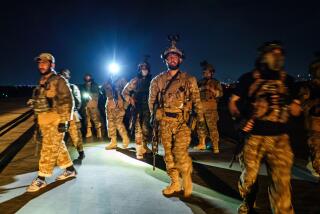Rumsfeld Sounds an Upbeat Note on the Air Campaign
- Share via
WASHINGTON — U.S. airstrikes in Afghanistan have significantly reduced the Taliban’s ability to defend itself against Afghan opposition forces but have moved the United States only marginally closer to finding Osama bin Laden, Defense Secretary Donald H. Rumsfeld said Thursday.
“The Taliban’s ability to effectively oppose the forces on the ground that are in opposition to the Taliban is degraded and diminished,” Rumsfeld said at a Pentagon news conference.
Rumsfeld’s relatively upbeat assessment appeared to contrast with the Pentagon’s appraisal the day before, when Rear Adm. John D. Stufflebeem, a senior official with the Joint Chiefs of Staff, said that the U.S. faces a tough struggle against the surprisingly resilient Taliban.
But with the military campaign still relatively young, both assessments may be true, defense analyst Harlan K. Ullman said. Progress against Taliban defenses may not lead immediately to the overthrow of the Islamic regime, he said.
And progress against Taliban troops does not necessarily mean progress in finding leaders of Bin Laden’s Al Qaeda terrorist network, as Rumsfeld stressed. The defense secretary said the lack of good intelligence on Bin Laden’s whereabouts has been a persistent problem.
“There isn’t any progress. You either have him or you don’t,” he said. “Until you have him, you do not have him--so what is progress? Until he is no longer functioning as a terrorist, he is functioning as a terrorist.”
Rumsfeld said the airstrikes have succeeded in hitting many of the Taliban’s surface-to-air missiles and aircraft, including transport helicopters and Soviet-made MIGs.
He acknowledged that the anti-Taliban Northern Alliance has not made significant progress in efforts to capture Kabul, the Afghan capital, or the key northern crossroads town of Mazar-i-Sharif, despite U.S.-led airstrikes in these areas.
But the anti-Taliban ground forces “are better off today than they were before [the bombing began Oct. 7], and they are in a position to be more successful,” he said.
Haron Amin, spokesman for the Northern Alliance in Washington, on Thursday continued to criticize the United States for a military strategy that he said has included only limited assistance to the opposition army.
U.S. military strategists “have made some choices [in their targeting], and those choices we think have in a sense prolonged the campaign,” Amin said.
In Afghanistan, Northern Alliance Gen. Abdul Rashid Dostum said Thursday that his forces have taken the town of Keshendeh about 40 miles south of Mazar-i-Sharif after heavy fighting with Taliban forces.
His troops are now trying to move northwest in an attempt to encircle the strategically important city, Dostum said in an interview by satellite phone.
“If we take over the area surrounding Mazar-i-Sharif, the city itself will be easier to take,” he said.
On Wednesday, another Northern Alliance leader acknowledged that the anti-Taliban forces this month had botched a chance to quickly capture Mazar-i-Sharif through tactical blunders and an overreliance on U.S. airstrikes.
While the Northern Alliance struggles to push forward against the Taliban, Rumsfeld said that even if it does, finding Bin Laden is “like looking for a needle in a haystack. I suspect it’s easier to change the Taliban leadership over time than . . . find a specific person.”
Rumsfeld said Washington had not been able to get timely intelligence on Bin Laden’s whereabouts. “Does he move? Sure he moves. Have we located him, in a way that allowed us to do anything about it? No,” Rumsfeld said.
Gen. Richard B. Myers, chairman of the Joint Chiefs of Staff, told reporters that in Wednesday’s air attacks, 80 jets and bombers hit nine target areas across Afghanistan and pursued Taliban forces wherever they could be found.
Myers showed photos depicting strikes against Taliban tanks in ravines and gullies near the city of Herat in western Afghanistan. Myers said the strikes “hit seven or eight” of the armored vehicles.
He also showed several videos from Navy F-14 and F/A-18 Hornet strike aircraft, which he said depicted explosions of warehouses and maintenance complexes.
*
Schrader reported from Washington and Paddock from Uzbekistan.
More to Read
Sign up for Essential California
The most important California stories and recommendations in your inbox every morning.
You may occasionally receive promotional content from the Los Angeles Times.










